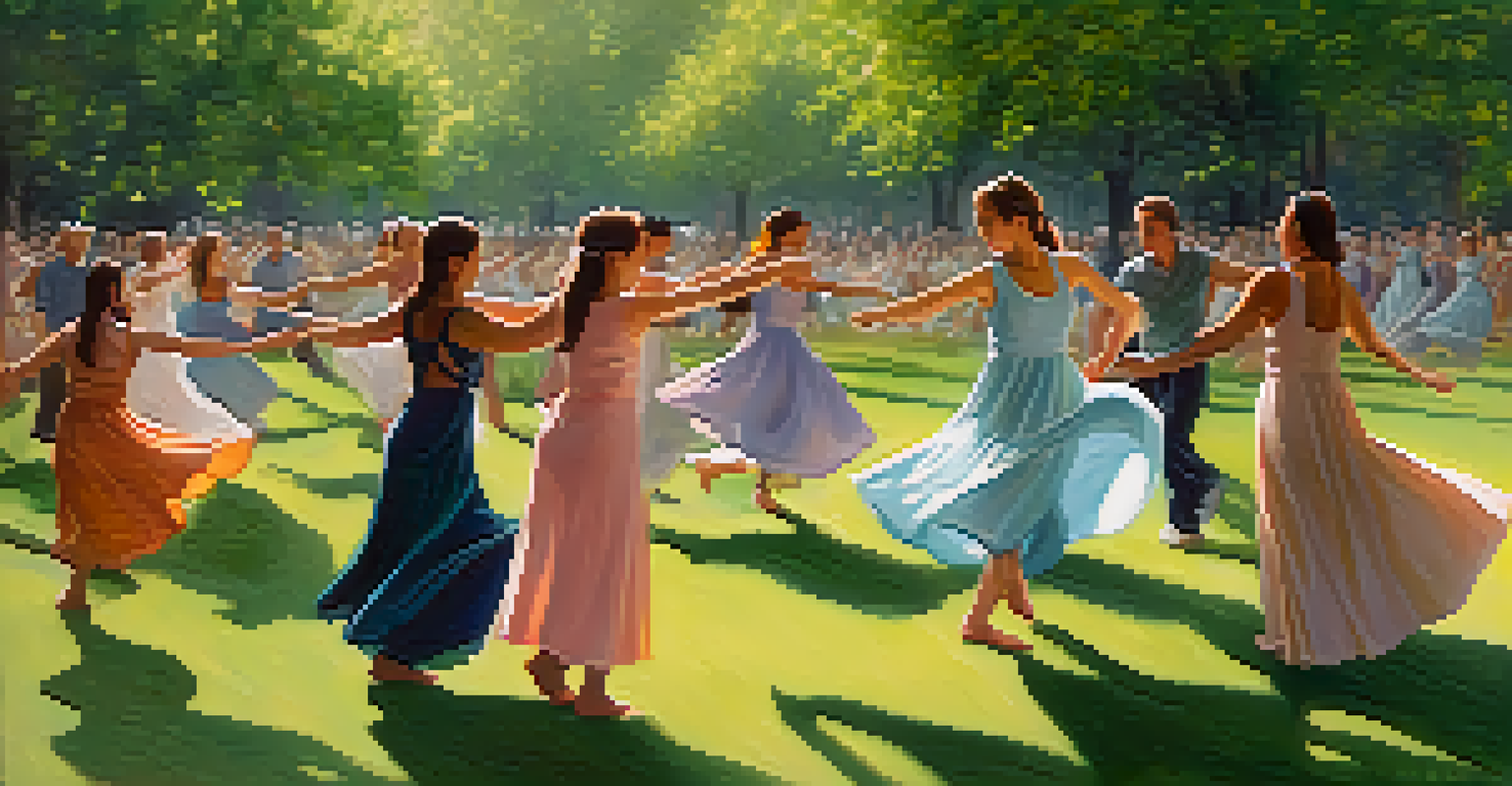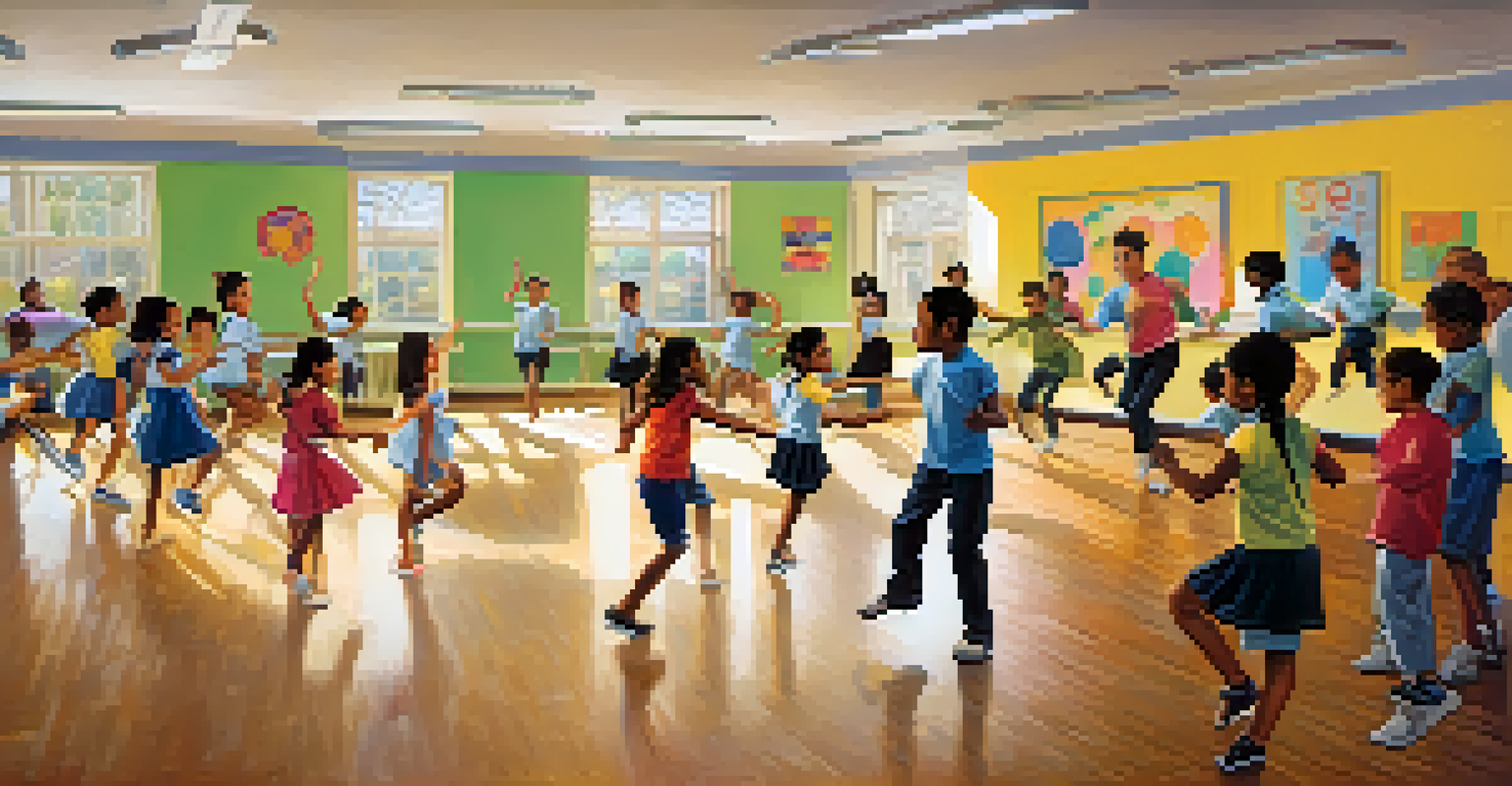The Neuroscience of Dance: Memory and Learning Insights

How Dance Engages the Brain: A Scientific Perspective
Dance is more than just an art form; it’s a complex interaction of cognitive processes. When we dance, our brains light up with activity, engaging various areas responsible for movement, memory, and emotion. This engagement can enhance our cognitive abilities, making dance a powerful tool for learning.
Dance is the hidden language of the soul.
Research shows that the rhythm and coordination required in dance stimulate neural connections. This stimulation can help improve our memory retention, as the brain makes stronger connections when we learn through movement. Think of it as a workout for your brain, where each step and beat reinforces your cognitive skills.
Moreover, the social aspect of dance adds another layer to its cognitive benefits. Dancing with others requires communication and teamwork, which boosts social cognition and emotional intelligence. This blend of physical and social engagement makes dance an enriching experience for both the mind and body.
The Role of Memory in Dance: How We Remember Steps
Memory plays a crucial role in dance, as dancers must recall choreography and musicality. This reliance on memory highlights the brain's ability to encode, store, and retrieve information, much like studying for an exam. For dancers, repetition is key; the more they practice, the more ingrained the movements become.

Interestingly, the type of memory used in dance is often procedural memory, which is the unconscious memory of skills and tasks. It’s what allows dancers to perform intricate routines without consciously thinking about each movement. This kind of memory is powerful and can last a lifetime, even if the dancer has taken a break.
Dance Boosts Brain Function
Engaging in dance stimulates cognitive processes, enhancing memory, learning, and emotional intelligence.
Moreover, the emotional connections to music and dance can enhance memory recall. When dancers associate specific movements with emotions or stories, they create a deeper memory link. This connection can lead to a more profound understanding and appreciation of the dance, making it a holistic learning experience.
Physical Benefits of Dance: Enhancing Brain Function
Beyond memory, dancing also offers numerous physical benefits that contribute to brain health. Regular physical activity, including dance, increases blood flow to the brain, promoting the growth of new neurons and enhancing overall cognitive function. This is crucial as we age, helping to stave off cognitive decline.
To watch us dance is to hear our hearts speak.
Moreover, dance can improve coordination, balance, and flexibility, which are vital for maintaining physical health. When our bodies are in good shape, our brains tend to follow suit. Imagine your brain as a well-oiled machine, where each part works better when the whole system is functioning optimally.
Incorporating dance into your routine can also improve mood and reduce stress. The release of endorphins during physical activity acts as a natural mood lifter, which can enhance mental clarity and focus. Thus, dance serves as a joyful way to boost both physical and mental wellness.
Dance Styles and Their Cognitive Effects: A Closer Look
Different dance styles can evoke various cognitive responses, making each form a unique experience. For example, ballet emphasizes precision and control, engaging the brain's focus and discipline. In contrast, styles like hip-hop encourage creativity and self-expression, engaging different cognitive pathways.
The diversity in dance styles allows for a versatile approach to learning. Engaging with various genres can enhance adaptability and problem-solving skills, as dancers must switch gears and learn new techniques. This adaptability is a valuable life skill, fostering resilience in the face of challenges.
Memory's Role in Dance
Dancers rely on procedural memory to recall choreography, linking movements to emotions for deeper learning.
Furthermore, cultural dances often come with rich histories and stories, offering a deeper cognitive layer. Learning these dances not only improves physical skills but also provides context and meaning, enriching the learning experience. It’s like a history lesson wrapped in movement, making it both educational and entertaining.
Dance as a Tool for Education: Enhancing Learning Environments
Integrating dance into educational settings can significantly enhance learning outcomes. Studies show that students who participated in dance programs demonstrated improved academic performance and engagement. This is because movement stimulates the brain, making learning more dynamic and impactful.
Dance can also be used to teach various subjects, from math to history. For instance, counting beats in music can reinforce mathematical concepts, while dance styles from different cultures can provide historical context. This multi-sensory approach caters to different learning styles, making education more inclusive.
Moreover, the act of dancing together fosters a sense of community and collaboration among students. This social engagement can reduce anxiety and build confidence, essential components for effective learning. Ultimately, incorporating dance into education can create a more vibrant and successful learning environment.
The Neuroscience of Dance Therapy: Healing Through Movement
Dance therapy harnesses the power of movement to promote healing and emotional well-being. This therapeutic approach encourages individuals to express their feelings through dance, facilitating emotional release and self-discovery. It’s a gentle reminder that our bodies and minds are intricately connected.
Research indicates that dance therapy can be particularly beneficial for individuals dealing with trauma, anxiety, or depression. The rhythmic movements and creative expression can help rewire the brain, fostering resilience and coping strategies. This process can be likened to a brain reset, allowing for new patterns of thought and behavior.
Dance Therapy Promotes Healing
Dance therapy fosters emotional well-being and connection, helping individuals cope with trauma and build community.
Additionally, dance therapy often builds a supportive community among participants, which can be incredibly healing. Sharing experiences in a safe space can mitigate feelings of isolation and foster a sense of belonging. Thus, dance therapy not only promotes individual healing but also strengthens social bonds.
Future Directions: The Intersection of Dance and Neuroscience
As research in neuroscience continues to evolve, the understanding of dance's impact on the brain is expanding. Future studies may explore the neurological mechanisms behind why dance is so effective for learning and memory, leading to more innovative applications. Imagine a future where dance is a staple in educational and therapeutic settings, backed by solid science.
Furthermore, technology could play a significant role in this intersection. Virtual reality and motion capture could provide insights into how dance affects brain activity in real-time. These advancements could lead to personalized dance programs tailored to individual learning and therapeutic needs.

Ultimately, the synergy between dance and neuroscience holds great promise for enhancing our understanding of human cognition and health. As we continue to explore this fascinating connection, dance may well prove to be a key player in unlocking our brain’s full potential.